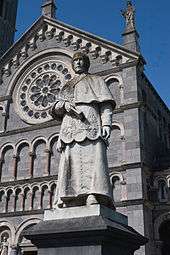Pietro Lazzarini
Pietro Lazzarini (5 January 1842 – 1918) was an Italian sculptor.
Biography
He descended from a family of sculptors who ran a marble workshop in Carrara from 1670 until 1942. The sculptor Giuseppe Lazzarini was his brother.[1] He submitted a bas relief of Evander retrieves the body of Pallas for a competition, and was awarded a stipend by the government to study at the Academy of Fine Arts of Florence. He returned to work to Carrara.
Among his first mature works are the Martyrdom of four saints, found in the main altar of the Lombard church of Carrara. This he followed it with Leda and Bacchus donated to the Academy of Carrara. Then he sculpted After the Bath, a nude female statua exhibited at the Accademia Fiorentina, where it was awarded a gold medal.
He sculpted a bas-relief medallion of princess della Cisterna. For the Soldiers' National Monument in Gettysburg, Pennsylvania, USA he helped design the five larger than life statues of History, War, Abundance, Industry, and Victory that are around the base of a tall granite column.[2]
In 1869, he moved to Berlin, where he excelled in portraiture. In 1881 at the Exhibition of Milan, he exhibited The Pastime. In Paris, he exhibited The Innocence.
One of his notable work was a marble rood screen (c. 1899) in the Cathedral of St. Patrick, in Armagh.[3]
 Tympanum of Madonna and child at St Macartan's Cathedral, Monaghan[4]
Tympanum of Madonna and child at St Macartan's Cathedral, Monaghan[4] Tympanum of Christ giving the keys at St Macartan's Cathedral, Monaghan[4]
Tympanum of Christ giving the keys at St Macartan's Cathedral, Monaghan[4] Statue of Saint Peter at St Macartan's Cathedral, Monaghan[5]
Statue of Saint Peter at St Macartan's Cathedral, Monaghan[5]
References
- Jaffe, Irma B. (1992). The Italian Presence in American Art, 1860–1920. Fordham University Press. pp. 136–. ISBN 978-0-8232-1342-9. Retrieved 9 February 2013.
- Dizionario degli Artisti Italiani Viventi: pittori, scultori, e Architetti., by Angelo de Gubernatis. Tipe dei Successori Le Monnier, 1889, page 258.
- "Pietro Lazzarini". Mapping the Practice and Profession of Sculpture in Britain and Ireland 1851–1951. University of Glasgow History of Art and HATII, online database 2011. Retrieved 10 February 2013.
- Mulligan, Kevin V. (2013). South Ulster – The Counties of Armagh, Cavan and Monaghan. The Buildings of Ireland. Yale University Press. p. 464. ISBN 978-0-300-18601-7.
- Williams, Jeremy (1994). A Companion Guide to Architecture in Ireland 1837–1921. Irish Academic Press. p. 320. ISBN 0-7165-2513-5.
- Galloway, Peter (1992). The Cathedrals of Ireland. Belfast: The Institute of Irish Studies. p. 204. ISBN 0-85389-452-3.